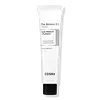What's inside
What's inside
 Key Ingredients
Key Ingredients

 Benefits
Benefits

 Concerns
Concerns

No concerns
 Ingredients Side-by-side
Ingredients Side-by-side

Water
Skin ConditioningCaprylic/Capric Triglyceride
MaskingPropanediol
SolventGlycerin
HumectantTocopheryl Acetate
AntioxidantCetearyl Alcohol
EmollientButyrospermum Parkii Butter
Skin ConditioningPanthenol
Skin ConditioningTrehalose
HumectantGlycine Soja Oil
EmollientAmmonium Acryloyldimethyltaurate/Vp Copolymer
Dimethicone
EmollientGlyceryl Polymethacrylate
Helianthus Annuus Seed Oil
EmollientPolyglyceryl-10 Stearate
Skin ConditioningHydrogenated Lecithin
EmulsifyingHydroxyethyl Acrylate/Sodium Acryloyldimethyl Taurate Copolymer
Emulsion StabilisingCarbomer
Emulsion StabilisingTromethamine
BufferingGlyceryl Stearate
EmollientPolysilicone-11
Sodium Sulfite
PreservativeTocopherol
AntioxidantDaucus Carota Sativa Root Extract
Skin ConditioningAllantoin
Skin ConditioningGlyceryl Caprylate
EmollientOryza Sativa Bran Wax
Skin ConditioningRetinol
Skin ConditioningTocotrienols
Skin ConditioningStearic Acid
CleansingPolyglyceryl-3 Methylglucose Distearate
EmulsifyingPalmitic Acid
EmollientDisodium EDTA
Ethylhexylglycerin
Skin ConditioningAdenosine
Skin ConditioningSorbitan Isostearate
EmulsifyingElaeis Guineensis Oil
EmollientBHT
AntioxidantBeta-Carotene
Skin ConditioningMyristic Acid
CleansingLauric Acid
Cleansing3-O-Ethyl Ascorbic Acid
Skin ConditioningAscorbic Acid
AntioxidantGlutathione
Limnanthes Alba Seed Oil
Skin ConditioningSodium Hyaluronate
Humectant1,2-Hexanediol
Skin ConditioningHydrolyzed Hyaluronic Acid
HumectantSodium Hyaluronate Crosspolymer
HumectantHyaluronic Acid
HumectantSodium Acetylated Hyaluronate
HumectantWater, Caprylic/Capric Triglyceride, Propanediol, Glycerin, Tocopheryl Acetate, Cetearyl Alcohol, Butyrospermum Parkii Butter, Panthenol, Trehalose, Glycine Soja Oil, Ammonium Acryloyldimethyltaurate/Vp Copolymer, Dimethicone, Glyceryl Polymethacrylate, Helianthus Annuus Seed Oil, Polyglyceryl-10 Stearate, Hydrogenated Lecithin, Hydroxyethyl Acrylate/Sodium Acryloyldimethyl Taurate Copolymer, Carbomer, Tromethamine, Glyceryl Stearate, Polysilicone-11, Sodium Sulfite, Tocopherol, Daucus Carota Sativa Root Extract, Allantoin, Glyceryl Caprylate, Oryza Sativa Bran Wax, Retinol, Tocotrienols, Stearic Acid, Polyglyceryl-3 Methylglucose Distearate, Palmitic Acid, Disodium EDTA, Ethylhexylglycerin, Adenosine, Sorbitan Isostearate, Elaeis Guineensis Oil, BHT, Beta-Carotene, Myristic Acid, Lauric Acid, 3-O-Ethyl Ascorbic Acid, Ascorbic Acid, Glutathione, Limnanthes Alba Seed Oil, Sodium Hyaluronate, 1,2-Hexanediol, Hydrolyzed Hyaluronic Acid, Sodium Hyaluronate Crosspolymer, Hyaluronic Acid, Sodium Acetylated Hyaluronate
Water
Skin ConditioningGlycerin
HumectantPotassium Azeloyl Diglycinate
Skin ConditioningButylene Glycol
HumectantTranexamic Acid
AstringentAlpha-Arbutin
AntioxidantBiosaccharide Gum-1
HumectantSodium Polyacryloyldimethyl Taurate
Emulsion StabilisingPolyacrylate Crosspolymer-6
Emulsion StabilisingChlorphenesin
AntimicrobialPhenoxyethanol
PreservativeSodium Metabisulfite
AntioxidantSodium Diethylenetriamine Pentamethylene Phosphonate
Sodium Gluceptate
Trehalose
HumectantDisodium EDTA
Sodium Hyaluronate
HumectantWater, Glycerin, Potassium Azeloyl Diglycinate, Butylene Glycol, Tranexamic Acid, Alpha-Arbutin, Biosaccharide Gum-1, Sodium Polyacryloyldimethyl Taurate, Polyacrylate Crosspolymer-6, Chlorphenesin, Phenoxyethanol, Sodium Metabisulfite, Sodium Diethylenetriamine Pentamethylene Phosphonate, Sodium Gluceptate, Trehalose, Disodium EDTA, Sodium Hyaluronate
 Reviews
Reviews

Ingredients Explained
These ingredients are found in both products.
Ingredients higher up in an ingredient list are typically present in a larger amount.
Disodium EDTA plays a role in making products more stable by aiding other preservatives.
It is a chelating agent, meaning it neutralizes metal ions that may be found in a product.
Disodium EDTA is a salt of edetic acid and is found to be safe in cosmetic ingredients.
Learn more about Disodium EDTAGlycerin is already naturally found in your skin. It helps moisturize and protect your skin.
A study from 2016 found glycerin to be more effective as a humectant than AHAs and hyaluronic acid.
As a humectant, it helps the skin stay hydrated by pulling moisture to your skin. The low molecular weight of glycerin allows it to pull moisture into the deeper layers of your skin.
Hydrated skin improves your skin barrier; Your skin barrier helps protect against irritants and bacteria.
Glycerin has also been found to have antimicrobial and antiviral properties. Due to these properties, glycerin is often used in wound and burn treatments.
In cosmetics, glycerin is usually derived from plants such as soybean or palm. However, it can also be sourced from animals, such as tallow or animal fat.
This ingredient is organic, colorless, odorless, and non-toxic.
Glycerin is the name for this ingredient in American English. British English uses Glycerol/Glycerine.
Learn more about GlycerinSodium Hyaluronate is hyaluronic acid's salt form. It is commonly derived from the sodium salt of hyaluronic acid.
Like hyaluronic acid, it is great at holding water and acts as a humectant. This makes it a great skin hydrating ingredient.
Sodium Hyaluronate is naturally occurring in our bodies and is mostly found in eye fluid and joints.
These are some other common types of Hyaluronic Acid:
Learn more about Sodium HyaluronateTrehalose is a disaccharide made of two glucose molecules (glucose is sugar!). Trehalose is used to help moisturize skin. It also has antioxidant properties.
As a humectant, trehalose helps draw moisture from the air to your skin. This helps keep your skin hydrated.
Due to its antioxidant properties, trehalose may help with signs of aging. Antioxidants help fight free-radical molecules, unstable molecules that may damage your skin.
In medicine, trehalose and hyaluronic acid are used to help treat dry eyes.
Some animals, plants, and bacteria create trehalose as a source of energy to survive freeze or lack of water.
Learn more about TrehaloseWater. It's the most common cosmetic ingredient of all. You'll usually see it at the top of ingredient lists, meaning that it makes up the largest part of the product.
So why is it so popular? Water most often acts as a solvent - this means that it helps dissolve other ingredients into the formulation.
You'll also recognize water as that liquid we all need to stay alive. If you see this, drink a glass of water. Stay hydrated!
Learn more about Water